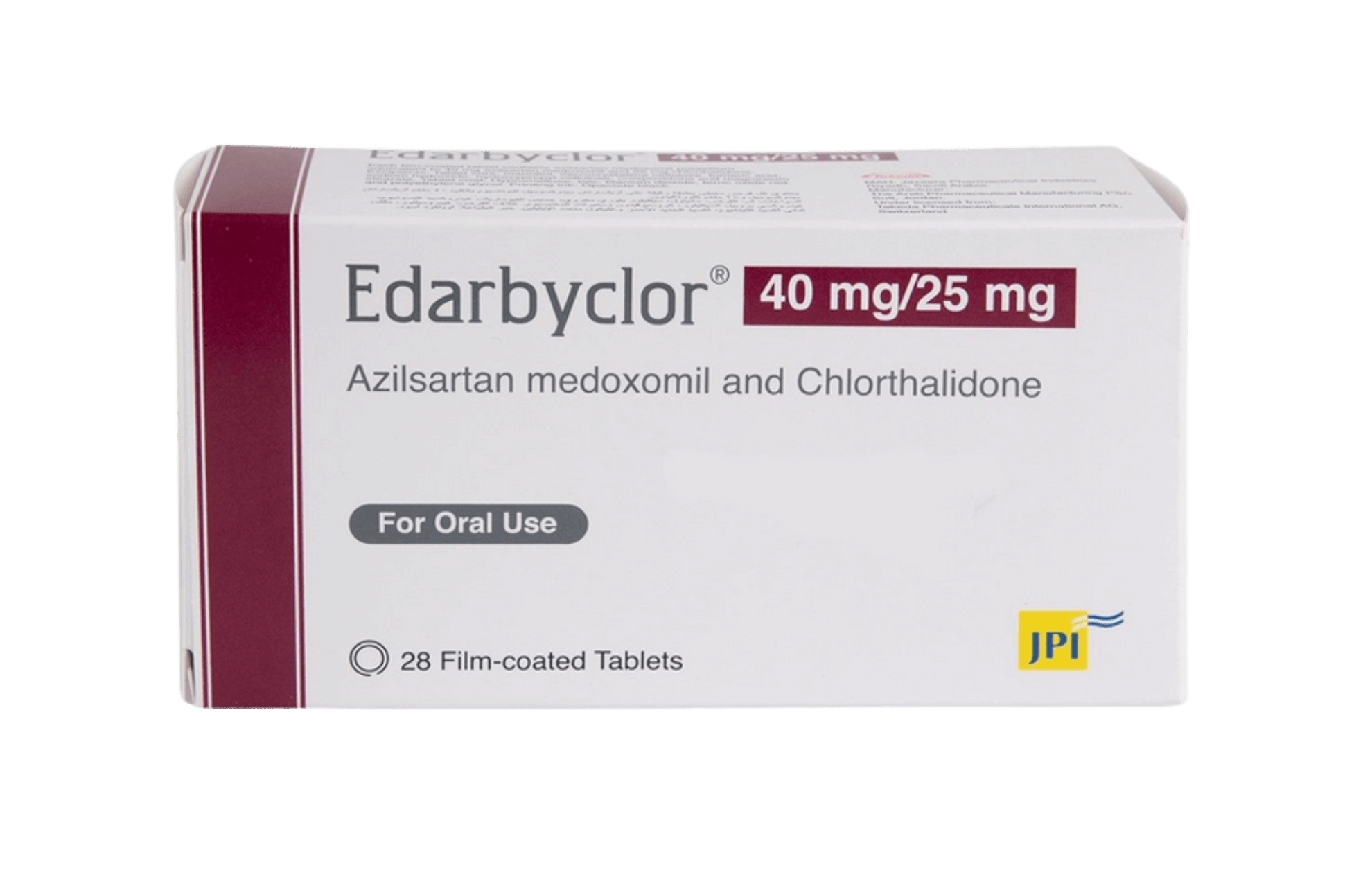Edarbyclor (generic name: azilsartan medoxomil and chlorthalidone) is specifically formulated to manage high blood pressure (hypertension) in adults. This combination therapy integrates two active ingredients: azilsartan medoxomil, an angiotensin II receptor blocker (ARB), and chlorthalidone, a thiazide-like diuretic. Edarbyclor offers a comprehensive approach to blood pressure control by merging these two agents.
Azilsartan medoxomil functions by inhibiting the action of angiotensin II, a natural substance in the body that constricts blood vessels. By blocking this effect, azilsartan medoxomil promotes the relaxation and widening of blood vessels, facilitating smoother blood flow and subsequently lowering blood pressure.
Chlorthalidone, on the other hand, acts as a diuretic. It aids the kidneys in eliminating excess sodium and water from the body through urine. This reduction in fluid volume contributes to decreased pressure within the blood vessels, complementing the effects of azilsartan.
The synergistic action of these components addresses hypertension through dual mechanisms: vascular relaxation and fluid reduction. Effective management of high blood pressure is crucial, as it significantly reduces the risk of serious cardiovascular events such as heart attacks and strokes.
Edarbyclor is typically prescribed for patients whose blood pressure is not adequately controlled with monotherapy or as an initial treatment for those likely to require multiple medications to achieve their blood pressure goals. It’s essential to understand that while Edarbyclor effectively manages hypertension, it is not a cure. Patients should continue their prescribed regimen even if they feel well, as hypertension often presents without noticeable symptoms.
For a more detailed understanding of hypertension and its management, resources like the American Heart Association provide comprehensive information.
Dosage
Edarbyclor is meant to be administered orally once daily. The recommended starting dose is 40 mg of azilsartan combined with 12.5 mg of chlorthalidone (40/12.5 mg). Most of the antihypertensive effect is apparent within one to two weeks. If further blood pressure reduction is necessary, the dosage may be increased to 40/25 mg after two to four weeks. Doses above 40/25 mg are not recommended, as they do not provide additional benefits.
Edarbyclor can be taken with or without food. It’s advisable to take the medication at the same time each day to maintain consistent blood levels. If a dose is missed, it should be taken as soon as remembered. However, if it’s almost time for the next dose, skip the missed dose and resume the regular dosing schedule. Do not double-dose to catch up.
Storage
Edarbyclor should be stored at room temperature, between 20-25°C (68-77°F). It should be kept in its original packaging to protect it from moisture and light. Avoid storing the medication in areas with high humidity, such as bathrooms.
Common Questions About Edarbyclor
How do azilsartan and chlorthalidone work together to lower blood pressure?
Azilsartan and chlorthalidone work synergistically to lower blood pressure through complementary mechanisms. Azilsartan blocks the action of angiotensin II, a hormone that constricts blood vessels, leading to vessel relaxation and reduced blood pressure. Chlorthalidone is a diuretic that helps the kidneys eliminate excess sodium and water, decreasing blood volume and further lowering blood pressure. This combination effectively manages hypertension by addressing both vascular resistance and fluid retention.
Can Edarbyclor be taken during pregnancy?
Azilsartan and chlorthalidone are generally not recommended during pregnancy, especially during the second and third trimesters, due to potential risks to the developing fetus, including kidney problems and low blood pressure. If pregnancy is planned or discovered while taking this medication, it’s crucial to inform a healthcare provider immediately to discuss alternative treatments that are safer during pregnancy.
What lifestyle changes can help manage hypertension alongside medication?
In addition to medication, several lifestyle changes can help manage hypertension effectively:
-
Adopting a heart-healthy diet rich in fruits, vegetables, whole grains, and low-fat dairy products, while reducing sodium intake, can significantly lower blood pressure.
-
Engaging in regular physical activity, such as brisk walking for at least 30 minutes most days, strengthens the heart and improves blood pressure.
-
Maintaining a healthy weight reduces the strain on the heart and lowers blood pressure.
-
Practicing relaxation techniques like deep breathing, meditation, or yoga can help manage stress, which contributes to hypertension.
This text is for informational purposes only. Please consult a doctor or pharmacist before using any medication.
Read the information leaflet that comes with the medication.
Most people who use Edarbyclor do not experience any adverse side effects. Doctors prescribe this medication because they assess the benefits of such treatment outweigh any likely unwanted effects.
Caution
Edarbyclor contains chlorthalidone. Treatment with chlorthalidone may increase the risk of developing Sudden Eye Disorders such as:
- Myopia: sudden nearsightedness or blurred vision.
- Glaucoma: an increased pressure in your eyes, eye pain. Untreated, it may lead to permanent vision loss.
- Choroidal effusion: abnormal buildup of liquid in your eye that may result in vision changes.
If there are sudden vision changes, stop taking Edarbyclor and seek immediate medical help.
Some of the side effects that have been reported include:
- Dizziness, especially when standing up quickly.
- Fatigue.
- Muscle cramps, which may be due to changes in electrolyte levels.
- Increased urination, which is common with diuretics.
Not all side effects are listed here. If these or other unlisted symptoms persist or worsen, consult a healthcare provider or pharmacist.
Edarbyclor is approved for the treatment of hypertension (high blood pressure) in adults. Hypertension is a condition where the force of the blood against the artery walls is consistently too high, potentially leading to health problems like heart disease and stroke. Symptoms are often not noticeable, which is why it’s termed the “silent killer.” Regular monitoring is essential for diagnosis and management.













